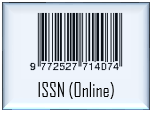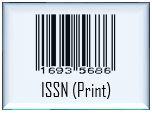THE EFFECT OF CANDESARTAN PRE-STROKE USE ON THE FUNCTIONAL OUTCOME OF POST ISCHEMIC STROKE PATIENTS IN BETHESDA HOSPITAL YOGYAKARTA
(1) DUTA WACANA CHRISTIAN UNIVERSITY
(2) Bethesda Hospital Yogyakarta, Jalan Jendral Sudirman No. 70, Kotabaru, Gondokusuman, Kota Yogyakarta, Daerah Istimewa Yogyakarta
(3) Panti Rapih Hospital, Jl. Cik Di Tiro No.30, Caturtunggal, Kec. Depok, Kabupaten Sleman 55223, Daerah Istimewa Yogyakarta
(*) Corresponding Author
Abstract
Stroke is a leading cause of death and disability, where the main risk factor is hypertension. Angiotensin Receptor Blocker (ARB) is the most common drug for stroke prevention in high-risk hypertensive patients. The purpose of this study was to see whether the candesartan pre-stroke use can improve the functional outcomes of post ischemic stroke patients. The data were obtained from 191 retrospective observational studies. Data were collected from Stroke Registry and medical record at Bethesda Hospital Yogyakarta in 2014-2016, then analyzed univariate, followed by bivariate analysis using chi-square test, independent t-test and fisher exact test for the variable which has actual count (F0), and logistic regression for multivariate analysis. One hundred and ninety one samples were systematically reviewed to evaluate the effect of candesartan pre-stroke use on functional outcomes of post ischemic stroke patients in Bethesda hospital Yogyakarta whose range of ages was mostly between 61 and 70 years (30.9%) and were mostly male patients (56.5%). Patients with good functional outcomes (<2) were 79.6% and poor functional outcomes (?2) were 20.4%. The results of bivariate analysis showed that candesartan did not affect the improvement of clinical outcome (OR: 1.806, 95% CI: 0.591-5.519, p: 0.294), and also not better than other angiotensin receptor blocker (p=0.505, OR=1.472, 95% CI= 0.470-4.611). The multivariate analysis showed that sex (OR: 0.366, 95% CI: 0.156-0.858, p: 0.021), loss of consciousness (OR: 0.107, 95% CI: 0.021-0.549, p: 0.007), limb weakness (OR: 0.236, 95% CI: 0.067-0.834, p: 0.025), dyslipidemia comorbidity (OR: 2.750, 95% CI: 1.177-6.427, p: 0.019) and aphasia (OR: 0.342, 95% CI: 0.107-1.100, p: 0.072) affected the functional outcome. The candesartan pre-stroke use did not improve the functional outcome of post ischemic stroke patient.
Keywords
Full Text:
PDFReferences
Bindawas, S.M., Mawajdeh, H., Vennu, V., and Alhaidary, H., 2016. A retrospective observational study of functional outcomes, length of stay, and discharge disposition after an inpatient stroke rehabilitation program in Saudi Arabia. Medicine (Baltimore), 95(31), e4432.
Center for Disease Control and Prevention, 2016. Top 10 Causes of Death [online]. Center for Disease Control and Prevention. Available from: https://www.cdc.gov/globalhealth/countries/indonesia/default.htm [Accessed 10 October 2017].
Chrysant, S.G., and Chrysant, G.S., 2006. The pleiotropic effects of angiotensin receptor blockers. The Journal of Clinical Hypertension, 8, 261-268.
Gargano, J.W., and Reeves, M.J., 2007. Sex Differences in Stroke Recovery and Stroke-Specific Quality of Life: Results from a Statewide Stroke Registry. Stroke, 38, 2541-2548.
Gray, V., Rice, C.L., and Garland, S.J., 2012. Factors That Influence Muscle Weakness Following Stroke and Their Clinical Implications: A Critical Review. Physiotherapy Canada, 64 (4), 415-426.
Kusuima, Y., Venketasubramanian, N., Kiemas, L.S., and Misbach, J., 2009. Burden of stroke in indonesia. World Stroke Organization International Journal of Stroke, 4, 379-380.
Lewington, S., Whitlock, G., Clarke, R., Sherliker, P., Emberson, J., Halsey, J., Qizilbash, N., Peto, R., and Collins, R., 2008. Blood cholesterol and vascular mortality by asulivange, sex, and blood pressure: a meta-analysis of individual data from 61 prospective studies with 55,000 vascular deaths. The Lancet, 370 (9602), 18291839.
Maas, M.B., Lev, M.H., Ay, H., Singhal, A.B., Greer, D.M., Smith, W.S., Harris, G.J., Halpern, E.F., Koroshetz, W.J., and Furie, K.L., 2012. The Prognosis for Aphasia in Stroke. Journal of Stroke and Cerebrovascular Diseases, 21 (5), 350-357.
Min, L.S., Duncan, P.W., Dew, P., and Keighley, J., 2005. Sex Differences in Stroke Recovery. Preventing Chronic Disease Public Health Research, Practice, And Policy, 2 (3), 1-11.
Ng, Y.S., Astrid, S., Silva, D.A.D., Tan, M.L.D., Tan, Y.L., and Chew, E., 2013. Functional Outcomes after Inpatient Rehabilitation in a Prospective Stroke Cohort. Proceedings of Singapore Healthcare, 22 (3), 175-182.
Pelisch, N., Hosomi, N., Ueno, M., et al., 2010. Systemic candesartan reduces brain angiotensin II via downregulation of brain reninangiotensin system. Hypertension Research, 33 (2), 161-4.
Persky, R.W., Turtzo, L.C., McCullough, L.D., 2010. Stroke in Women: Disparities and Outcomes. Current Cardiology Reports, 12 (1), 613.
Riset Kesehatan Dasar, 2013. Jakarta: Badan Penelitian dan Pengembangan Kesehatan, Departemen Kesehatan, Republik Indonesia.
Sandset, E.C., Bath, P.M.W., Boysen, G., Jatuzis, D., Korv, J., Luders, S., Murray, G.D., Richter, P.S., Roine, R.O., Terent, A., Thijs, V., and Berge, E., 2011. The angiotensin-receptor blocker candesartan for treatment of acute stroke (SCAST): a randomised, placebo-controlled, double-blind trial. The Lancet, 377 (9767), 741-750.
Sandset, EC., Jusufovic, M., Sandset, PM., Bath, PMW., and Berge, E., 2015. Effects of blood pressure-lowering treatment in different subtypes of acute ischemic stroke. Stroke, 46, 877-879.
Seltzer, A., Bregonzio, C., Armando, I., et al. 2004. Oral administration of an AT1 receptor antagonist prevents the central effects of angiotensin II in spontaneously hypertensive rats. Brain Research, 1028(1), 9-18.
Sullivan, K.M., and Soe, M.M., 2007. Documentation for Sample Size for a Cross-Sectional, Cohort, or Clinical Trial Studies.
Tsao, J.W., Hemphill, J.C., Johnston, S.C., Smith, W.S., and Bonovich, D.C., 2005. Initial Glasgow Comma Scale Score Predicts Outcome Following Thrombolysis for Posterior Circulation Stroke. Archives of Neurology, 62 (7), 1126-1129.
Tziomalos, K., Bouziana, S., Spanou, M., Papadopoulou, M., Giampatzis, V., Kazantzidou, P., Dourliou, V., Kostaki, S., Savopoulos, C., and Hatzitolios, A., 2014. Angiotensin receptor blockers improve functional outcome and reduce all-cause mortality in patients discharged after acute ischemic stroke. Journal of The American Society of Hypertension, 8(4), Suppl, e139.
Wang, H., Niewczyk, P., Divita, M., Camicia, M., Appelman, J., Mix, J., and Sandel, ME., 2014. Impact of pressure ulcers on outcomes in inpatient rehabilitation facilities. American Journal of Physical Medicine & Rehabilitation, 93 (3), 207216.
Yayasan Stroke Indonesia, 2016. Stroke penyebab kematian urutan pertama di rumah sakit Indonesia [online]. YASTROKI. Available from: http://www.yastroki.or.id/read.php?id=276 [Accessed 10 December 2016].
DOI: https://doi.org/10.24071/jpsc.00660
Refbacks
- There are currently no refbacks.
Copyright (c) 2018 Journal of Pharmaceutical Sciences and Community
Jurnal Farmasi Sains dan Komunitas (Journal of Pharmaceutical Sciences and Community)
Published by Faculty of Pharmacy, Universitas Sanata Dharma Yogyakarta

This work is licensed under a Creative Commons Attribution 4.0 International License.













.png)













